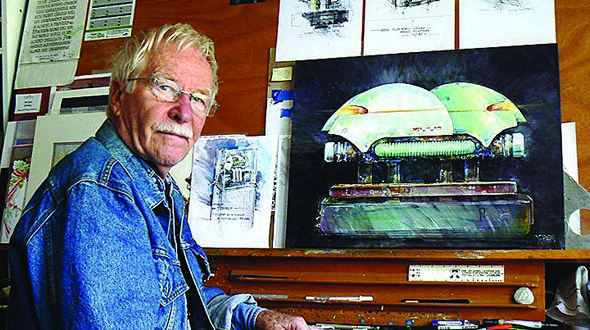
on his drawing board.
Ronald Shelley sits at the drawing board in his homebased studio in South Miami talking about a life of creative pursuits and a future with something new. For over 60 years Shelley has made his living as an illustrator and concept artist, actor and rodeo cowboy.
s an illustrator, his drawings graced book covers, magazine stories, brochures and greeting cards. In his career as a concept artist he worked for many renowned architects such as Charles Pawley, Kobi Karp and Lane Pettigrew, capturing their vision in watercolor renderings. His acting talents landed him numerous roles at the Coconut Grove Playhouse, on television, in movies and commercials. A SAG-AFTRA and Equity union member, Shelley has acted with Jose Ferrer, Stacy Keach and Cliff Robertson.
The rodeo gig brought him to the United States from his native England to be a wrangler, bronc-rider and actor in a Texasbased outfit he had worked when it toured as a wild-west show in France. For a number of years, Shelley was in the employ of the famed Bobby Estes, an inductee into the Rodeo Hall of Fame at the National Cowboy and Western Heritage Museum.

exploded view.
For Shelley, retirement doesn’t exist and his idea of relaxation is to draw and design practically every day. An award-winning artist for his Florida landscapes, his newest endeavor “Man as Machine” is a departure from two-dimensional paintings. This sculpture series is based on a concept the artist first experimented with decades ago. At the heart of the work is the artist’s interpretation of the way in which humans and machines have become intertwined.
“We thought we harnessed machines instead of horses to help with our work, instead, the machines have harnessed us,” said Shelley.
The prototype three-dimensional figure, “Steel Head” was made in cardboard and constructed on a base made from a car engine’s connecting rod. The helmet-headed figure with slots for eyes was later the subject of a painting that Shelley sold to a collector in Chicago in the 1970s.
Decades later the artist’s thoughts once again turned to the prototype. “I wanted to continue to explore this idea.
I wanted to invent something that went beyond creating pleasing pictures; something that revealed me,” said Shelley.
What the machine-themed sculptures and drawings disclose about the artist is his childhood fascination with the ways things work. Warplanes firing bullets in the skies over World War II England are among his earliest drawings; as are convoys of hefty American trucks and tanks lumbering along country roads. The fact that his father worked in the British Thompson-Huston factory in Rugby says something, too in this body of work that relies heavily on his skills as a model-maker.
Working back from the original smoothskinned aluminum head, Shelley is fashioning sculptures with exploded views of the interior and others as rusted or retired heads destined for the scrap heap. Telephone circuit boards, small LED lights and motorcycle carburetors are incorporated into the sculpture as the brain, the eyes and the mouth.
In addition to sculptures, Shelley continues to produce fine art paintings. See his work at www.shelleystudio.com and in his studio by appointment. Contact him at 786-251-2330 or visit online at cowboyshelley@yahoo.com






